Does the perfect 2 or 3 day San Sebastian itinerary exist? Well, after a few years of showing family and friends around, I think I’ve given it a pretty good shot!
There are endless things to do in San Sebastian and the nearby area, yet a thought out itinerary will help you make the most of your time in the city.
The aim of this guide is to show you how to best spend 24-hours, 48-hours, 72-hours or more in Donostia, regardless of the time of year you’re planning to visit.
Things to know before spending a day in San Sebastian
Before we dive into the best way to spend your time, there are a few things that are worth considering first.
1. How many days in San Sebastian?
Donostia is a fairly small, compact city. However, there’s a lot to see, crammed into the small space.
To see all of the best that San Sebastian has to offer, we recommend a stay of 3 days.
You can, of course, see this in a more condensed trip, which we’ll run through below. If you choose to stay a little longer, you won’t run out of things to do either. There’s plenty this city (and wider area) has to offer.
2. A well planned itinerary is key
Whilst the city is very walkable, you can rack up the miles on foot if you’re not sure where you’re going or don’t have a clear plan in mind.
Our 1 -3 day itinerary options below are designed to keep everything fairly close together so you don’t have to consistently walk from one end of the city to the other.
3. Pick a good base to stay
If you’ve read our guide on where to stay in San Sebastian, you’ll know that most of the main attractions are reachable on foot from certain areas.
We recommend choosing a hotel in the Area Romantica (Centre), Old Town, Gros or Antiguo, depending on your personal preferences. If you’re travelling to San Sebastian on the budget, there are also some great hostels in these areas.
The ultimate San Sebastian itinerary
OK, so we’ve built our itinerary based on the number of days in the city.
If you only have 24 hours in the city, then we recommend the “day 1” activities. If you’re here for 48 hours, then you should look to cover day 1 and day 2. Finally, if you’re staying for 72 hours or more, then you can cover all 3 days.
🏙️ One of the best ways to learn more about San Sebastian is to take one of the FREE Walking Tours
Day 1: Parte Vieja and La Concha Highlights
After a spot of breakfast, we recommend getting stuck into arguably San Sebastian’s crown jewel, La Concha beach.
1. La Concha Beach
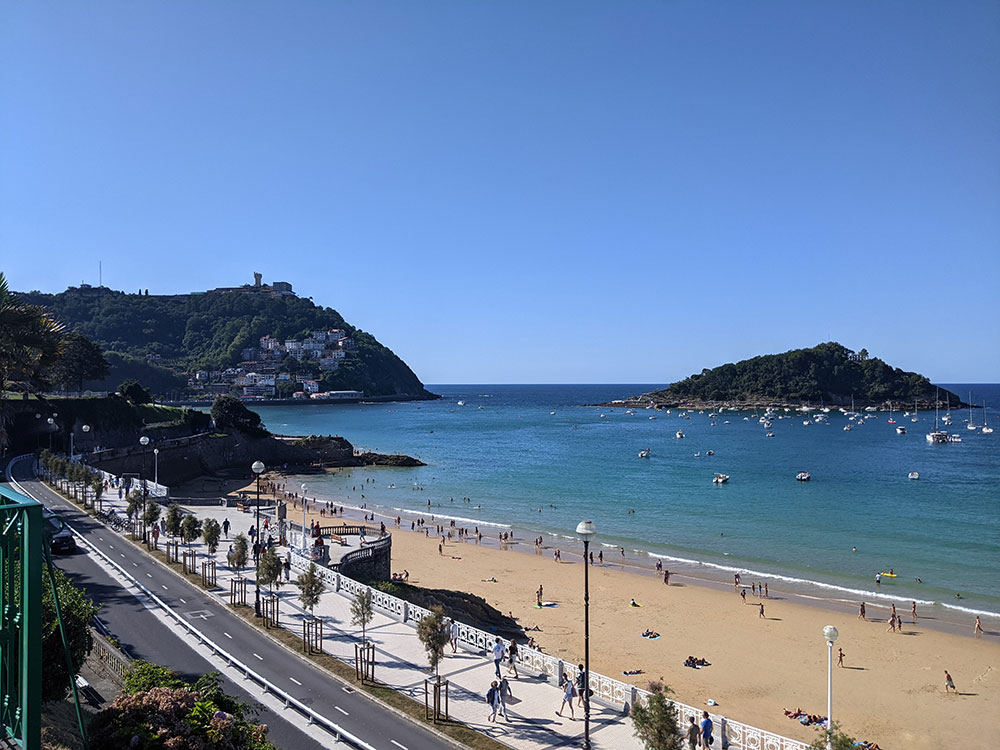
La Concha beach has been voted as one of the best beaches in the whole of Europe, and it’s not hard to see why. A picture-perfect setting, the view from the promenade is probably the most iconic image of San Sebastian.
No matter what time of year you visit the city, the first thing we recommend is to take a stroll on the promenade, the Paseo de La Concha.
Given the beach is right in the centre of Donostia, you don’t really have an excuse either!
If you’re visiting San Sebastian in the summer, it’s worth actually heading down to walk the beach. If you’re here in the winter, the promenade is the ideal location for a seaside stroll where you can admire the views of Santa Clara Island.
Either way, make your way from the Town hall round to Miramar Palace.
2. Miramar Palace

In the middle of the La Concha promenade is the Miramar Palace.
The palace dates back to 1893 when Queen Maria Christina purchased the land between La Concha beach and Ondarreta beach. She ordered that her summer retreat be built on the land in the style of an English cottage.
It covers a total of 3 and a half hectares and includes the main palace building, a number of outbuildings and the large gardens.
It’s one of the most iconic buildings in the city. On a nice day, the gardens are the perfect place to recharge your batteries with a view.
3. The Parte Vieja (Old Town)
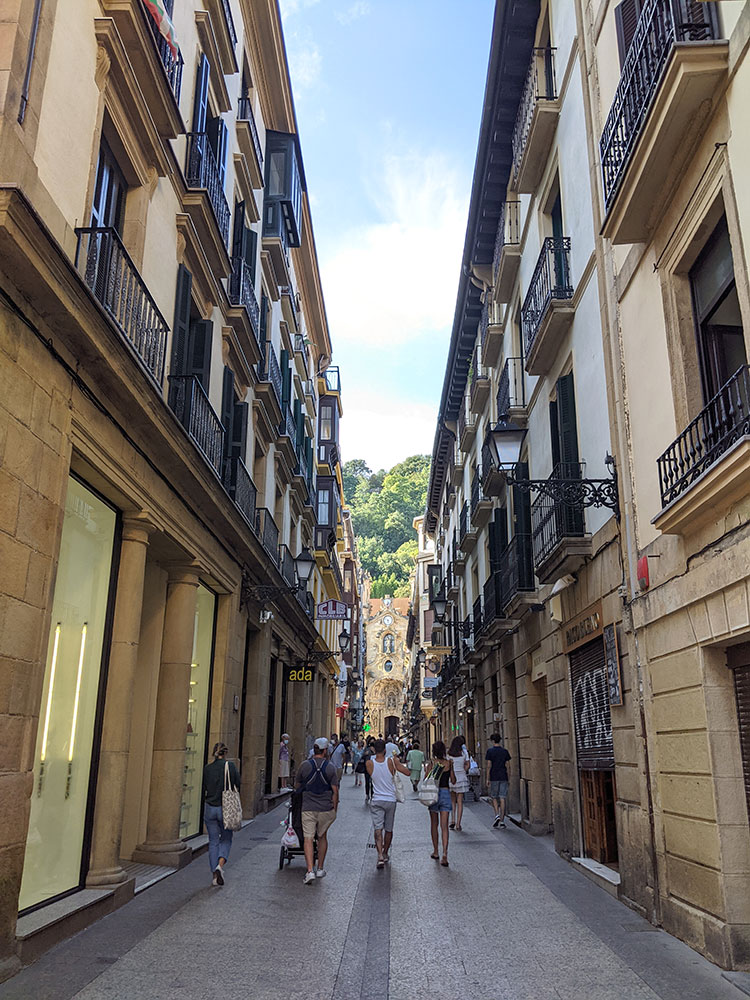
From the Miramar Palace you can head back towards the Town Hall to explore the Parte Vieja a little bit.
Previously, the Old Town of San Sebastian was completely surrounded by a city wall, before it was demolished in 1863 to make way for the new town.
Today, the Parte Viejas’s narrow streets are packed with pintxo bars, restaurants, bakeries and bars. The result is a thriving atmosphere full of different noises and smells.
If you’re up for it, I’d recommend taking one of the free walking tours that cover the Old Town and a little bit of the centre. They’ll take you to most of the highlights of these areas and explain a little bit about the city’s history.
If not, you can also cover the Old Town highlights off yourself.
The area contains some of the most important buildings and spaces in Donostia. You can check out what’s worth visiting in our guide to the Old Town here.
4. Pintxo Crawl
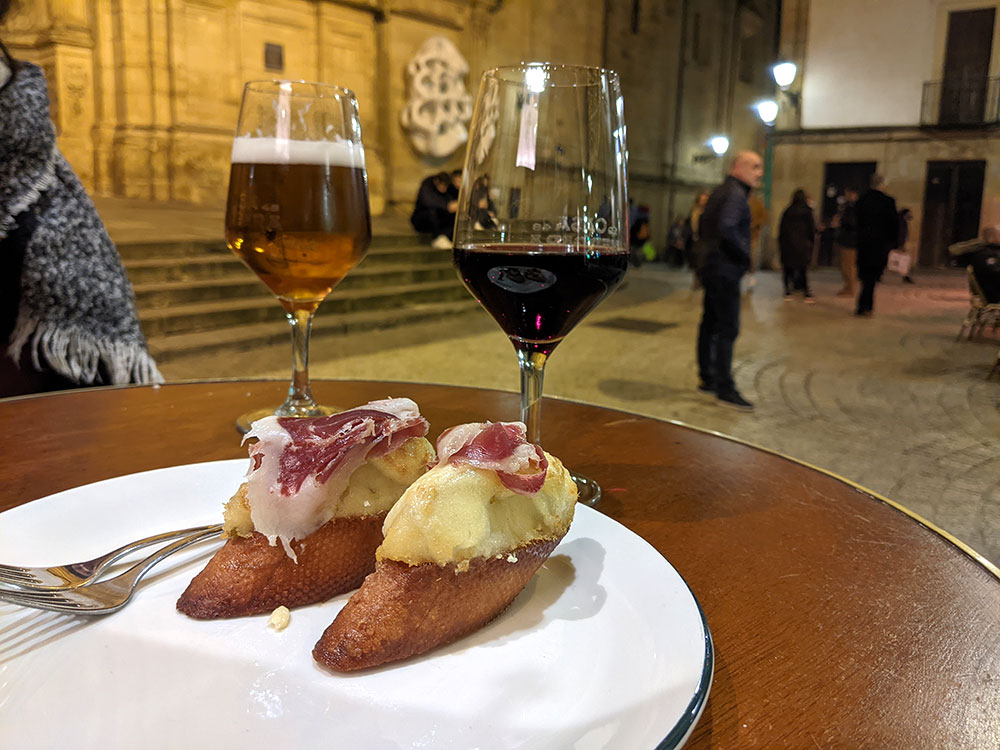
After a full-on day of walking around and visiting the city, it’s likely you’ll have worked up a bit of an appetite.
The good news is, San Sebastian has a worldwide reputation for the quality of its food. And one of things that set’s the city apart from others, are the pintxos.
Pintxos are small, appetiser-sized portions of food served in bars (they are ordered separately to your drink which is the main difference to the typical Spanish tapas).
The best way to get a taste for the best pintxos is to go from bar to bar in the Parte Vieja ordering a couple in each place. It’s quite a unique experience, and something a little different to other European cities.
Given its popularity, we’ve pulled together a whole separate guide on our recommended pintxo bars here.
🥘 Discover the best food San Sebastian has to offer on a Guided Food Tour
Day 2: Monte Igueldo and Gros
Now, these two districts may sit at opposite ends of the city, but we promise you that they are both worth visiting for different reasons.
1. Peine del Viento

Located at the bottom of Monte Igueldo, El Peine del Viento is an intriguing piece of art.
The huge steel sculptures sit on the rocks at the end of Ondarreta Beach and live in harmony with the waves.
When the sea is rough, the sculpture is at its most impressive. Water crashes against the rocks and blasts from the number of blow holes on the viewing platform.
2. Monte Igueldo

After visiting El Peine del Viento, it’s time to head up the mountain to the top of Monte Igueldo.
But don’t worry, we’re not going to make you walk.
The best way to reach the peak is actually via the funicular. It dates back to 1912, and its old equipment and wooden carriages have been expertly preserved. They are still in use today, which makes the funicular an attraction in its own right.

Once you reach the top, you’re treated with some of the best views of San Sebastian.
But this special mountain has another surprise, The Monte Igueldo Amusement Park. Opening in 1912, it’s been a prominent feature in San Sebastian for over 100 years.
The park is a mix of history and fun. You can ride some of the old wooden roller coasters from previous generations – which are still just as fun today!
There aren’t many theme parks in the world with as good views as those from Monte Suzia and Rio Misterioso.
3. Gros

After the morning on the West side of town, it’s time to head East to the Gros District.
This area has become known as the cool, hipster district of San Sebastian thanks to the Zurriola Beach, which sits at the heart of the barrio (area).
The waves here are the best for surfing, and hundreds of surfers flock from all over the world to spend the summer months in Gros. And all the young, cool surfers have brought a chilled-out, alternative vibe to Gros.
In the afternoon and at night, the area comes alive. There are plenty of bars and terraces to enjoy a drink and a bite to eat.
Check out our guide to the district to discover more about the things to see and do in Gros.
4. Take in the sunset

After a long couple of days of visiting the city, it’s time to take a bit of a rest. Sit back, relax and enjoy one of San Sebastian’s spectacular shows of nature.
Given the northern orientation of the city, the sun actually rises behind the beaches. You may notice that most of the sunbathers face away from the sea for this reason.
But what that does mean is that the sun sets in the city are incredible. Looking out over La Concha bay or La Zurriola beach, you’re treated to some beautiful skies as the sun hides behind Monte Igueldo or Santa Clara Island late in the day.
My favourite spot to watch the sunset has to be from the port, Paseo Nuevo or Sagüés.
Day 3: Monte Urgull, The River and The Island
Day three of our itinerary is dedicated to one of the other mountains in San Sebastian, Urgull, and the water.
1. Monte Urgull
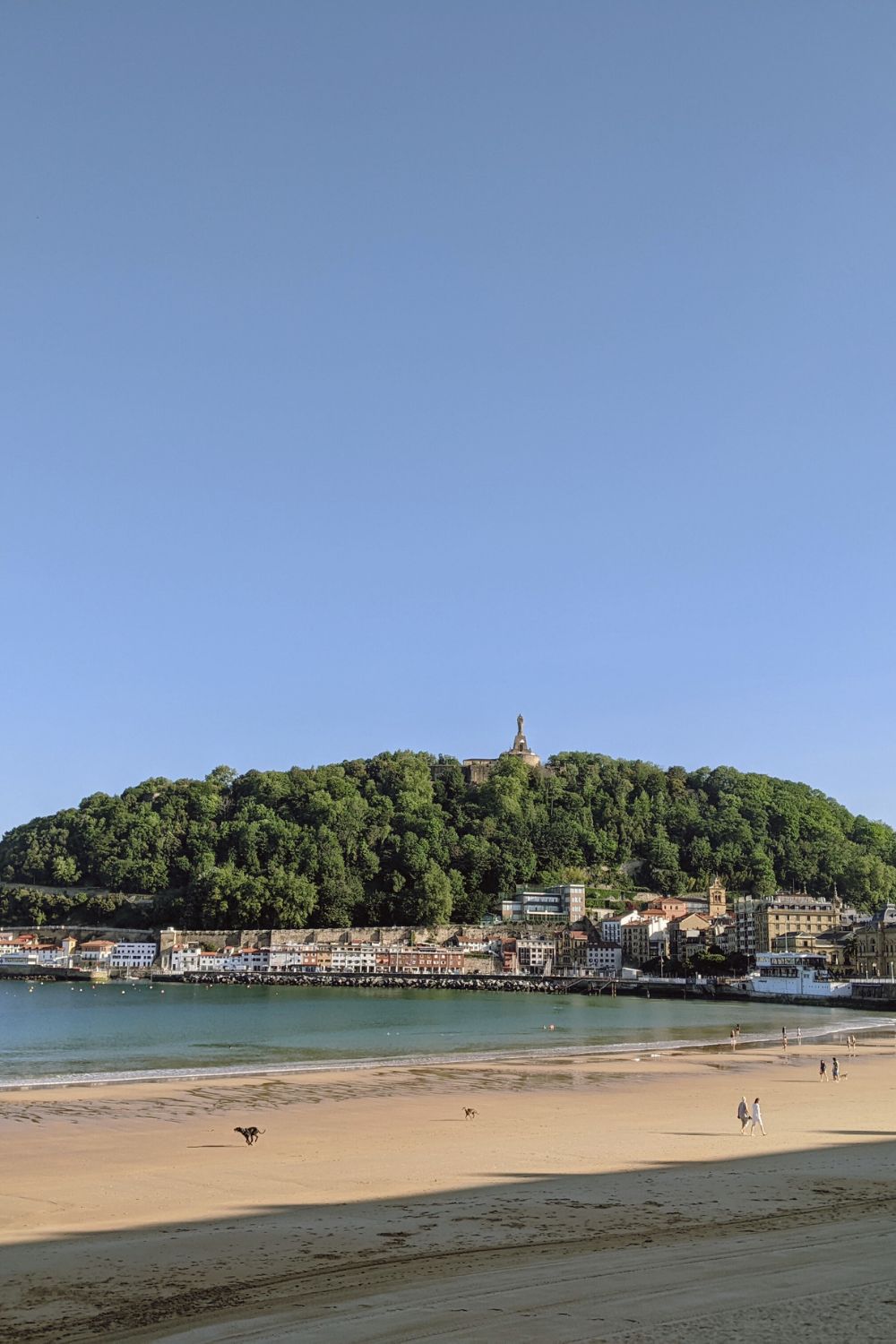
Standing high behind the Old Town, Monte Urgull is San Sebastian’s natural fortress.
The Castillo de la Mota (Mota Castle) sits on top of the mountain and acted as the city’s first defence. Since becoming a military base in the 12th century, Monte Urgull bears the scars of a number of sieges that have taken place in the city over the centuries.
Much like Monte Iguelso, there are impressive viewpoints on the way to the top. For anyone who manages the hike, El Polvorín (an open terrace bar) awaits with refreshments.
2. River Urumea
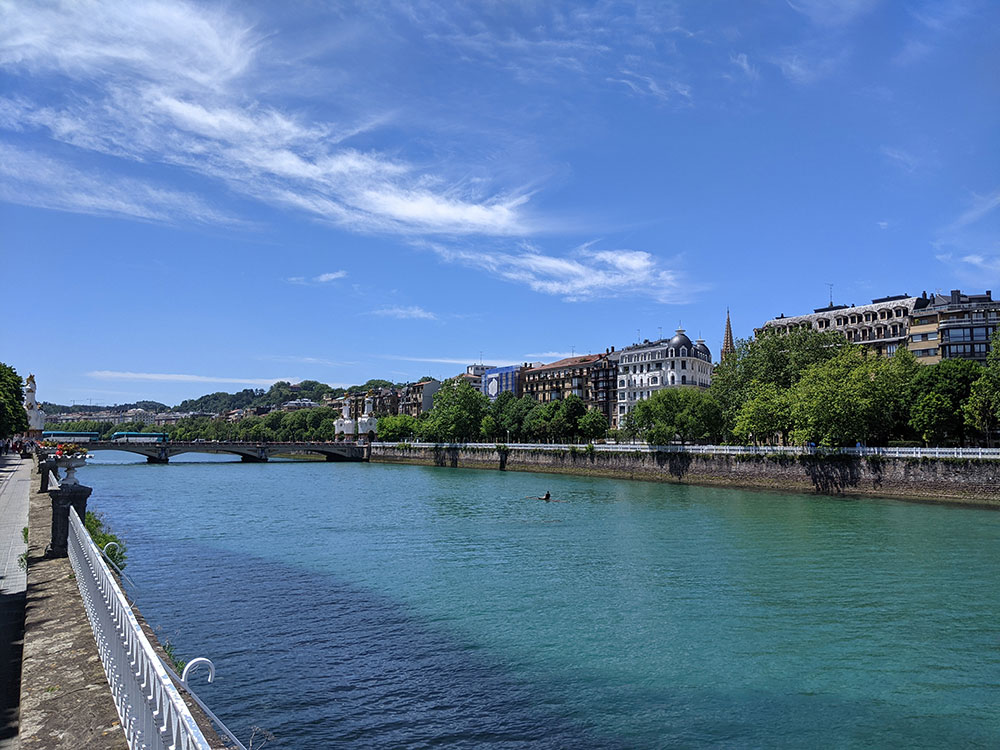
Heading back down to sea level, the River Urumea is a prominent feature that divides Donosti, splitting the city centre from the Gros and Egia barrios.
Traditionally the river was used as a means of transporting goods (mainly Basque cider) from the nearby local villages. Today however, you’re more likely to find kayakers – and even surfers!
The riverside has a number of landmarks along the way and some beautiful walkways making it a quiet, peaceful place to escape the city. If you want to rent a bike in San Sebastian, it’s also one of the best cycle routes around.
3. Boat Trip to Santa Clara Island
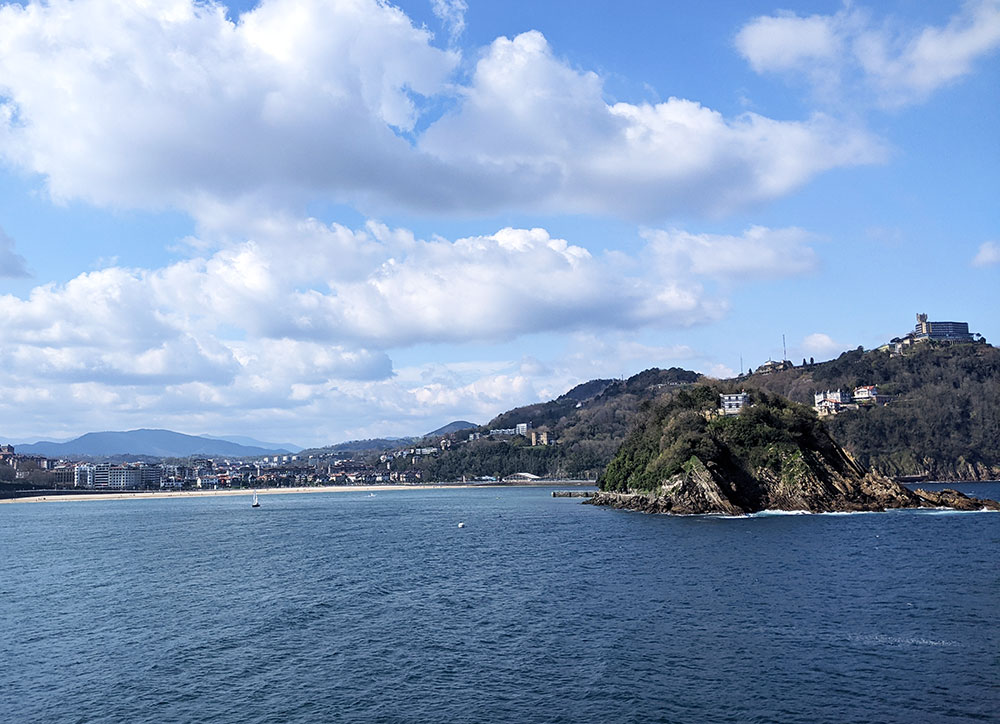
At the heart of La Concha Bay, Santa Clara Island is more than just a pretty thing to look at.
It measures just 400 metres wide, but there’s a lot packed into this small island with plenty of character.
It’s home to a lighthouse, Hondalea (an impressive geographical sculpture), San Sebastian’s fourth beach (with its own natural swimming pool), alongside plenty of chill out spots!
During the summer months (June – September) a boat taxi runs from the port in San Sebastian to Santa Clara Island.
The blue taxi line is a glass bottomed boat that will also give you a tour of La Concha Bay where you can get some unique views of the city and the impressive “flysch style” rock formations of Santa Clara Island.
A late afternoon, early evening trip is the perfect way to cap off 3 days in San Sebastian. You can find out more about the taxi boat here.
FAQs about San Sebastian Itineraries
In the section below, we’ve responded to the most FAQs that we haven’t covered in our itinerary.
If you have a question that we haven’t tackled, ask away in the comments section below and we’ll get back to you!
San Sebastian is 100% worth visiting. The city has it all; an interesting history, culture, events throughout the year, beautiful architecture, beaches, mountains and not to mention the food.
San Sebastian is a compact city, so you can cover off all the main attractions in 2 days. A full thought out itinerary will help you make the most of your time, however, to get a full flavour of Donostia, we’d recommend a trip of 3 days.
